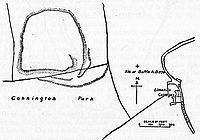- Battle of Cynwit
-
Battle of Cynwit Part of the Viking-Saxon wars Date 878 Location May be Cannington, Somerset, but this is uncertain Result Decisive Saxon victory Belligerents 
West Saxons
VikingsCommanders and leaders Ealdorman Odda of Devon Ubbe Ragnarsson† Strength Unknown 1200 Casualties and losses Unknown Unknown The Battle of Cynwit, also spelt Battle of Cynuit, took place in 878 at a fort which Asser calls Cynwit. This is now argued to be on Cannington Hill, near Cannington, Bridgwater in Somerset, England,[1] but other locations are also put forward for it.
A party of Vikings led by Ubbe Ragnarsson, brother of Ivar the Boneless and Halfdan Ragnarsson, landed on the coast at Combwich with 23 ships and twelve hundred men. There they observed that a number of English Thanes and all of their men had taken refuge in the fort of "Cynwit" for safety. While the fort was secure on all sides except for the East, it lacked adequate fortifications. Thus Ubbe and the Vikings proceeded to besiege the fort, expecting the English to surrender eventually from lack of water (as there was no available source near the fort). The English however, instead of waiting to die of thirst on top of the hill, attacked suddenly out of the fortress at dawn, taking the Danes by surprise and winning a great victory.
While the Anglo-Saxon Chronicle glosses over the battle of Cynwit, it is important for two reasons.
Firstly, it was an important victory for the English won by someone other than Alfred the Great, the king of Wessex at the time who was spearheading the English resistance to the Viking invasions. The Chronicle, in addressing the year 878, makes the claim that: "all but Alfred the King" had been subdued by the Vikings. Alfred, as it turns out, was actually hiding elsewhere with a small band of followers. Credit for the victory at Cynwit – as revealed by Æthelweard - is due to Ealdorman Odda of Devon, who is mentioned neither in the Anglo-Saxon Chronicle nor in Asser’s Life of King Alfred, most likely out of reverence for Alfred’s status as king. The Battle of Cynwit shows that while Alfred was a major force in uniting the English peoples against the Danes, a number of local Ealdormen still held sway over the peoples of Wessex.
Secondly, at the battle of Cynwit, Odda and the English forces not only succeeded in killing Ubba, but they also captured the Raven banner called Hrefn or the Raven. While the Anglo-Saxon Chronicle only briefly mentions the battle, it does draw attention to the capture of the banner, which is interesting considering that it does not single out any other trophy captured by the English in the many other victories they had against the Danes. This banner was special because out of the three commanding brothers of the Vikings – Halfdan, Ivar, and Ubbe – Ubbe was the most superstitious and prone to consultation of pagan seers to dictate his course of action in battle. As Ubba’s battle flag, the Raven banner therefore held specific ritual meaning amongst the Danes, and is even described as being as ritually important to the Danes as the ‘holy ring’ that the Danes used to declare their peace with Alfred after the battle of Edington some months later.
The battle in fiction
The battle appears in The Marsh King, a children's historical novel by C. Walter Hodges, where its location is called "Kynwit". Although this novel is about King Alfred, it gives due credit to Ealdorman Odda for this victory, although the description of the battle may not be very accurate.
The battle also features in Bernard Cornwell's novel The Last Kingdom. Cornwell ascribes the victory, as well as the killing of Ubbe, to his fictional hero Uhtred.
References
- ^ "Cannington". British History Online. http://www.british-history.ac.uk/report.aspx?compid=18555&strquery=Cannington. Retrieved 2008-01-13.
- The Anglo-Saxon Chronicle
- Asser, The Life of King Alfred
- Æthelweard, Chronicon, ed. and tr. Alistair Campbell, The Chronicle of Æthelweard (London, 1961)
- Cornwell, Bernard, The Last Kingdom (London: Harper Collins, 2005)
- Keary C. F., The Vikings in Western Christendom (T. Fisher Unwin: London)1891.
- Smyth, Alfred P., King Alfred the Great (Oxford University Press: Oxford) 1995.
Categories:- 878
- 9th-century conflicts
- 9th century in England
- Battles involving Wessex
- Battles involving the Vikings
- Military history of Somerset
Wikimedia Foundation. 2010.

